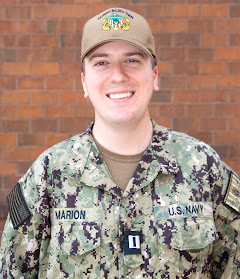By Megan Brown
Navy Office of Community Outreach
KINGS BAY, Ga. — Submariners make up only 10 percent of the U.S. Navy’s personnel, but they play a critical role in carrying out one of the Defense Department’s most important missions: strategic deterrence. Lt. Spencer Marion, a native of Peachtree City, Georgia, is one of the sailors supporting a 123-year tradition of service under the sea to help ensure Americans’ safety.
Marion joined the Navy eight years ago and today serves with Commander Submarine Group 10.
“I joined the Navy because I was coming up on college graduation and was not interested in corporate jobs,” said Marion. “I saw the Blue Angels flying on the beach in Pensacola and I was excited to find out that there were ways to serve my country and live in beach towns.”
Growing up in Peachtree City, Marion attended Starr’s Mill High School and graduated in 2011.
Skills and values similar to those found in Peachtree City are similar to those required to succeed in the military.
“A lot of my town’s leaders are military veterans and that taught me a lot about how to be a good American and a good man in society,” said Marion.
These lessons have helped Marion while serving in the Navy.
Known as America’s “Apex Predators!,” the Navy’s submarine force operates a large fleet of technically-advanced vessels. These submarines are capable of conducting rapid defensive and offensive operations around the world, in furtherance of U.S. national security.
There are three basic types of submarines: fast-attack submarines (SSN), ballistic-missile submarines (SSBN) and guided-missile submarines (SSGN). Fast-attack submarines are designed to hunt down and destroy enemy submarines and surface ships; strike targets ashore with cruise missiles; carry and deliver Navy SEALs; conduct intelligence, surveillance, and reconnaissance missions; and engage in mine warfare. The Virginia-class SSN is the most advanced submarine in the world today. It combines stealth and payload capability to meet Combatant Commanders’ demands in this era of strategic competition.
The Navy’s ballistic-missile submarines, often referred to as “boomers,” serve as a strategic deterrent by providing an undetectable platform for submarine-launched ballistic missiles. SSBNs are designed specifically for stealth, extended patrols and the precise delivery of missiles. The Columbia-class SSBN will be the largest, most capable and most advanced submarine produced by the U.S. — replacing the current Ohio-class ballistic-missile submarines to ensure continuous sea-based strategic deterrence into the 2080s.
Guided-missile submarines provide the Navy with unprecedented strike and special operation mission capabilities from a stealthy, clandestine platform. Each SSGN is capable of carrying 154 Tomahawk cruise missiles, plus a complement of heavyweight torpedoes to be fired through four torpedo tubes.
“Our mission remains timeless — to provide our fellow citizens with nothing less than the very best Navy: fully combat ready at all times, focused on warfighting excellence, and committed to superior leadership at every single level,” said Adm. Mike Gilday, Chief of Naval Operations. “This is our calling. And I cannot imagine a calling more worthy.”
Strategic deterrence is the nation’s ultimate insurance program, according to Navy officials. As a member of the submarine force, Marion is part of a rich history of the U.S. Navy’s most versatile weapons platform, capable of taking the fight to the enemy in the defense of America and its allies.
Serving in the Navy means Marion is part of a team that is taking on new importance in America’s focus on strengthening alliances, modernizing capabilities, increasing capacities and maintaining military readiness in support of the National Defense Strategy.
“We are a global economy and the Navy ensures international trade remains free and open,” said Marion. “The other reason our Navy is important to national defense is because our adversaries’ militaries are increasing in size. We allow our nation’s military to access remote regions of the world to keep the fight away from the homeland.”
With 90 percent of global commerce traveling by sea and access to the internet relying on the security of undersea fiber optic cables, Navy officials continue to emphasize that the prosperity of the United States is directly linked to trained sailors and a strong Navy.
Marion and the sailors they serve with have many opportunities to achieve accomplishments during their military service.
“My proudest accomplishment is qualifying as a conning officer aboard USS Ronald Reagan, an aircraft carrier deployed in Japan,” said Marion. “There is a book called ‘Time Enough for Love’ by Robert Heinlin and it talks about the diversification of things gentlemen should learn like taking care of the sick, solving equations and conning a warship.”
As Marion and other sailors continue to train and perform missions, they take pride in serving their country in the United States Navy.
“I take pride that we are a volunteer service and that my service means that my friends can continue to live normal American lives at home without having to do what I do,” said Marion. “Being a sailor means I get to follow in the footsteps of our nation’s heroes and leaders who served in the Navy before me.”
Marion is grateful to others for helping make a Navy career possible.
“I want to thank my father, Randy, who served the country as an Air Force pilot for taking care of my family growing up,” added Marion. “I also want to thank my mom, Brenda, for supporting me in general but especially during my many moves.”













Leave a Comment
You must be logged in to post a comment.